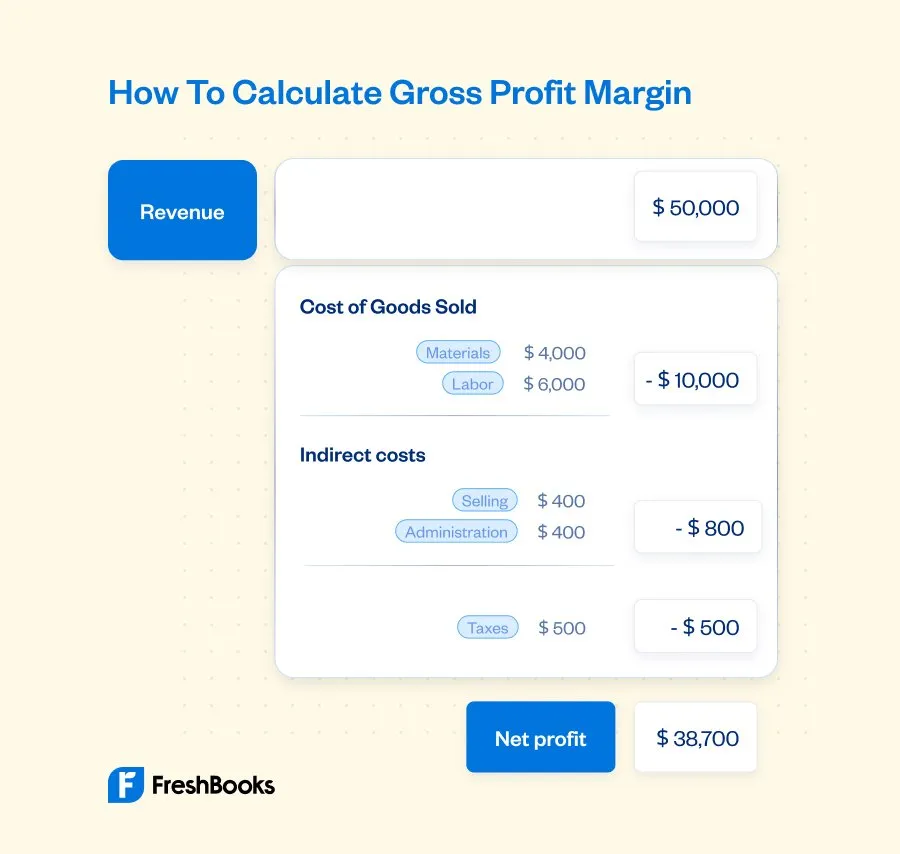Gross Profit Margin: Formula, Calculation and Example

Gross profit margin is an important metric that measures the revenue your company retains after deducting basic operating costs. It’s an indicator of a company’s financial health and can be used to track growth and create strategies for growing profits.
Gross profit margin is calculated by subtracting the cost of goods sold from your business’s total revenues for a given period. Good gross profits vary by industry, and new businesses typically have a smaller gross profit ratio. The aim is to steadily increase your gross profit margin as your business gets established.
We’ll explore what gross profit margin is, how to calculate it, and work through some examples. We’ll also discuss strategies for increasing your gross profit margin so you can boost your profits and expand your small business.
Key Takeaways
- Gross profit margin measures the revenues a company keeps after deducting operating costs.
- You can calculate gross profit margin by subtracting cost of goods sold from total revenue.
- Gross profit margins vary significantly across different industries.
- Businesses should aim to steadily increase gross profit margin ratio.
- Gross profit margin indicates financial health and can be used to analyze operational efficiency.
Table of Contents
- What Is Gross Profit Margin?
- Gross Profit Margin Formula
- How To Calculate Gross Profit Margin
- What Is a Good Gross Profit Margin?
- Why Is Gross Profit Margin Ratio Important?
- How To Analyze Gross Profit Margin
- How Can You Increase Your Gross Profit Margin?
- The Relationship Between Gross Profit Margin and Net Profit Margin
- Why Should You Calculate Operating Margin?
- Final Thoughts: Evaluating Gross Profit Margin
- Frequently Asked Questions
What Is Gross Profit Margin?
Gross profit margin is a type of profit margin where the cost of goods sold is subtracted from total revenue. It’s the most straightforward measure of profit margin and shows how much money a company retains after accounting for the cost of the goods.
Gross profit margin is usually expressed as a percentage. It’s helpful for measuring how changes in the cost of goods can impact a company’s profits. Changes in gross profit margin are used to analyze trends in profitability and the cost of inputs.
You can also use your gross margin percentage to compare your profits to those of similar businesses in your industry. Since they likely have a similar cost of goods sold, you can use this metric to compare your total sales revenue.

Gross Profit Margin Formula
The formula for gross profit margin calculation is:
Gross Profit Margin = (Total Revenue – Cost of Goods Sold) / Total Revenue
Total revenue is the final amount of your net sales for a given period. This includes any discounts, returns, and other interactions that can impact the final amount from your sales.
Cost of goods sold is the amount of money required to produce your product. These operating expenses include any materials costs and labor needed to make the product itself. This does not include labor and other costs associated with sales, administration, and distribution. Cost of goods sold can be thought of as the basic cost of doing business.
How To Calculate Gross Profit Margin
We’ll show you how to calculate gross margin with an example. This is Company A’s income statement for the last quarter:

Company A sells sheds and brings in a total of $50,000 for a given period. They have $50,000 in total revenue.
They spent $4,000 on materials and paid their employees $6,000 to build the sheds. This means they spent $10,000 in cost of goods sold.
Gross Profit Margin = (Total Revenue – Cost of Goods Sold) / Total Revenue
Gross profit margin = ($50,000 – $10,000) / $50,000
Gross profit margin = 0.8
We can multiply this by 100 to get a gross profit margin of 80%.
Note that in this case, we can ignore the indirect costs and taxes on the income statement. These are used for calculating net profit but are not necessary for gross profit margin.
What Is a Good Gross Profit Margin?
A good gross margin ratio is often considered to be anywhere between 50% to 70%. However, this is a very simplistic measurement—gross profit margins vary significantly between industries, so there’s not one number that indicates a good gross profit ratio.
Gross Profit Across Industries
It’s important to note that gross profit margins are very different for different industries. For example, businesses like banks and law firms that have low input costs typically report very high gross profit margins. In these industries, a good gross profit margin is often in the high 90%.
In contrast, industries like clothing sales tend to have high input costs since they have to account for both labor and materials. A clothing retailer might have a gross profit margin of anywhere from 5% to 13% and still be considered a healthy business.
Fast food retailers often have a gross profit ratio somewhere in the middle, around 30% to 40%. When assessing a good gross margin, avoid comparing across industries and instead compare companies of similar size in the same industry.
Gross Profit for New Companies
Even within the same industry, gross profit margins can vary. New businesses will usually have a smaller gross profit margin as they establish their practices and build their customer base. This doesn’t mean the business is doing poorly—it’s simply an indicator that they’re developing their systems.
New companies should expect their gross profits to be several percentage points lower than established companies in the same industry. The more important metric is how your company’s gross profit margin changes. You should aim for steady growth in your gross profit margin as your business gradually expands and you establish your customer base.
If you find that your gross profit margin does not grow, it’s an opportunity to re-examine your pricing strategy, assess your operational efficiency, or re-consider your vendors. This helps you to either increase your total revenue or decrease your operating costs.
Why Is Gross Profit Margin Ratio Important?
Gross profit margin is an important metric for measuring the overall financial health of your business. If you have a negative gross profit ratio, it means your basic cost of doing business is greater than your total revenue. A positive gross profit ratio shows that you’re successfully covering your operating costs and generating a profit.
You can use this information to pinpoint elements of your sales that are going well or to cut ineffective practices. Analyzing changes in your company’s gross margin helps you track trends in financial health.
How To Analyze Gross Profit Margin
We’ll explore the basic steps for generating an overview of your company’s gross profits:
1. Calculate Your Gross Profit Margin
Start by using the gross profit margin formula to calculate your gross profit margin percentage. This is normally done quarterly, but some businesses choose to calculate profit margins every month.
2. Compare It to Your Company’s History
Measure your current gross profit margin against your previous data. This helps you notice any trends in your company’s productivity. The goal is to achieve steady growth in your gross profit margin.
3. Consider Industry Standards
Take into account general profit margins in your industry. Learn the typical range for a company of your size to assess whether you’re in line with industry standards.
4. Compare Against Your Competitors
Finally, compare your gross profit margins against your direct competitors. If you find they report significantly higher gross margins, consider what they might be doing differently and whether it could apply to your company. Although you might not be able to match them in size or volume of product sold, you may discover they’re purchasing materials from a more affordable vendor.
How Can You Increase Your Gross Profit Margin?
There are two main ways to increase your gross profit margin: increasing revenue or decreasing cost of goods sold. We’ll explore a few strategies to help you increase gross profits:
1. Expand Your Customer Base
Growing your customer base can help you increase your sales and boost revenue. Consider how you can use marketing strategies to find new customers or increase the purchase volume of existing customers. Check whether your competitors are reaching customers you might be missing—for example, with different social media platforms or targeted ads to specific groups.
2. Reconsider Your Pricing Strategy
Pricing is another way to reach new customers. If your prices are too high, customers may turn to your competitors. If they’re too low, you might not be able to cover input costs. Compare your prices against competitors and calculate whether you can match or compete. If you can’t drop your prices, see whether you can compete by offering better service or more appealing branding.
3. Reduce Your Materials Costs
Reducing the cost of goods sold will increase your company’s gross profit margin. Check whether your current vendor is offering the most affordable inventory prices. If not, consider switching to a new retailer or asking for a discount from your current provider.
4. Assess Your Products
If you offer multiple goods or services, you may discover they don’t all perform equally well. Even products that sell a large volume may not be very profitable if they demand a large amount of materials and labor costs. Assess which products deliver the best profit and consider whether you could cut poorly performing products and focus on more profitable ones.
The Relationship Between Gross Profit Margin and Net Profit Margin
Gross profit margin is an important metric for comparing revenue and production costs, but it’s not the most comprehensive picture of your business’s profits. Net profit margin offers a more in-depth analysis that accounts for taxes, interest, and dividends as well as cost of goods sold.
These indirect costs can have a significant impact on a company’s profit margin. Net profit margin includes all the direct costs and indirect costs that go into running a business, from labor to administration and general costs.
Net profit margin is also important for securing loans and financing. Banks and investors may ask to see net profits to demonstrate that your company can successfully generate a profit after all costs are accounted for.
Why Should You Calculate Operating Margin?
Calculating gross margin allows a company’s management to better understand its profitability in a general sense. But it does not account for important financial considerations like administration and personnel costs, which are included in the operating margin calculation.
If not managed properly, these indirect costs can really eat into a company’s profit. Often administration and personnel costs are where management will make their first cutbacks because those types of reductions will not affect a company’s core operations, which are vital to the survival of a business.
Final Thoughts: Evaluating Gross Profit Margin
Gross profit margin assesses a company’s profitability and growth. It measures how much revenue a company keeps after deducting basic operating costs, which can help businesses find opportunities to increase efficiency.
The right expense tracker helps you catch excess expenses so you can stay on top of your operating costs. FreshBooks expense tracking software makes it easy to upload and categorize expenses so you can track how much your business is spending on different elements. Try FreshBooks free to get started tracking your expenses, reducing costs, and growing your gross profit margin today.

FAQs About Gross Profit Margin
Learn more about gross profit in different industries, the difference between gross profit and profit margin, and high profit margins with these answers to frequently asked questions.
What business has the highest profit margin?
The businesses with the highest profit margins are typically service industries like law, banking, and software development. They have low operating costs because they don’t have inventory, which means they subtract less in cost of goods sold and retain more of their revenue.
What is the difference between margin and gross margin?
Gross profit margin is a type of margin that accounts for basic operating costs like materials and labor associated with producing your product. Other profit margins like net profit margin include more deductions like administrative costs and taxes, giving a smaller overall profit margin calculation.
What is the difference between profit margin and gross profit?
Gross profit is revenues minus cost of goods sold, which gives a whole number. Gross profit margin divides that by revenue and multiplies it by 100% to give a percentage. They will tell you the same basic relationship of revenues to costs but expressed in different ways.
Why do investors care about gross margin?
Investors care about gross margin because it demonstrates a company’s ability to sell their products at a profit. A positive gross margin proves that a company’s sales exceed their production costs.
What is a good gross profit margin for a small business?
Gross profit margins vary significantly across industries, so you can assess a good gross margin by looking at the normal range for small companies in your industry. New businesses often have a smaller gross profit margin but that does not mean that they aren’t financially healthy.
What happens if gross profit margin is too high?
High gross profit margins indicate that your company is selling a large volume of goods or services compared to your production costs. This generally indicates that your business is doing well. High gross profit margins are not a cause for concern.
About the author
Kristen Slavin is a CPA with 16 years of experience, specializing in accounting, bookkeeping, and tax services for small businesses. A member of the CPA Association of BC, she also holds a Master’s Degree in Business Administration from Simon Fraser University. In her spare time, Kristen enjoys camping, hiking, and road tripping with her husband and two children. In 2022 Kristen founded K10 Accounting. The firm offers bookkeeping and accounting services for business and personal needs, as well as ERP consulting and audit assistance.
RELATED ARTICLES


 Bank Reconciliation: Definition, Example, and Process
Bank Reconciliation: Definition, Example, and Process What is Solvency vs Liquidity?
What is Solvency vs Liquidity? How to Calculate FIFO and LIFO
How to Calculate FIFO and LIFO How To Prepare An Income Statement
How To Prepare An Income Statement Single-Entry Bookkeeping: Single-Entry vs Double-Entry
Single-Entry Bookkeeping: Single-Entry vs Double-Entry What Are the Different Types of Accounting Systems? Options Explained
What Are the Different Types of Accounting Systems? Options Explained